- Remarks by Frank Paluch, President, Honda R&D Americas, Inc. and Yoshiyuki Matsumoto, President and CEO, Honda R&D Co Ltd.
FRANK PALUCH
Hello everyone.
Happy New Year and welcome to the Honda display at CES. Cooperation is at the heart of CES. It’s why we’re excited to be starting the year off among the world’s top tech influencers, who come together here in Vegas to share ideas, find new ways to collaborate, and, in turn, change the world in which we live.
In a few minutes, you’ll hear from our global R&D president about a direction we’re calling the “Cooperative Mobility Ecosystem.” But first I want to highlight a few of our technology themes.
Like all of you, we’re here to help shape the future direction of technology which includes radically re-thinking the mobility experience based on our goal to create something new that advances mobility making people’s lives better. Robotics, AI, and big data are central to this experience, as is a culture of open innovation and collaboration.
It is this nexus of transformative technologies and open innovation that forms Honda’s Cooperative Mobility Ecosystem where vehicles will communicate with one another – as well as with infrastructure – to mitigate traffic congestion, and ultimately, eliminate traffic fatalities.
In this new ecosystem, everyone using the road will experience increased productivity, and a more enjoyable journey. New models will emerge in which your own car can earn you money even when you’re not in the vehicle.
The autonomous age has dawned, and Honda, like all automakers, is constantly refining and advancing this technology. Automated vehicle technology is not just about realizing the automated driving function. It is crucial for improving advanced driver assistance and active safety such as collision avoidance.
Today, we’re showing one pathway toward this goal. It’s a concept we call Safe Swarm. Drawing on biomimicry, Safe Swarm is innovation inspired by nature looking for clues in the natural world to solve challenges we have created for ourselves.
By using vehicle-to-vehicle and vehicle-to-infrastructure communications drawing upon cloud-based big data and employing artificial intelligence for decision making, we are working with others to create an environment in which road conditions are predicted, managed and problems are avoided. Merging into traffic will become seamless, and traffic jams will be mitigated by coordination among everyone using the road.
Of course, this ecosystem is not something Honda can create alone. Again, this is why we’re here at CES. This challenge requires the cooperation of industries; local, state, and federal government and individuals. Toward this kind of advanced collaboration, we’re already beginning to plan for the first real world application of V2V and V2I technology – right in our own backyard.
Last year, Honda announced its participation in the Smart City program in Columbus, Ohio and the US 33 Intelligent Corridor project. These federal and state funded projects in Ohio will give us an opportunity to study and participate in the development of vehicle to infrastructure communications and this can enhance the safety and efficiency of our nation’s highway systems.
But making our roads safer and reducing driver workload is just one part of our vision for a Cooperative Mobility Ecosystem. By reaching outside the auto industry, even as we collaborate within it, we’re developing technologies that will enhance the mobility experience, and make it more accessible and enjoyable.
As one example, we are set to debut a new Honda-specific Android based operating system in a new Honda vehicle developed with Wind River. This new operating system is the basis for future HMI integration in our products, providing us a more efficient path forward for the creation of very intuitive and intelligent connected systems. And it demonstrates that we are open for innovation partnership, particularly in the realm of software.
This convergence of auto and tech has put Silicon Valley at the forefront of mobility innovation, which is why Honda established its own Silicon Valley lab to collaborate with entrepreneurs, startups, and global tech companies.
In the past several years, we announced two initiatives to further these strategic alliances, the Honda Xcelerator and the Honda Developer Studio. Honda Xcelerator is working with startups and entrepreneurs to bring to market new in-vehicle technologies that support the driving experience. Two great examples of this are Vocal Zoom and LEIA 3D, companies we are showcasing here at CES.
One of the big challenges with today’s infotainment systems is the ability of onboard computers to understand the driver’s voice commands. Current acoustic microphones listen to everything in the car, including ambient noise. But through its optical microphone it can actually interpret the physical vibrations generated by a speaker’s voice. Then Vocal Zoom can separate the speaker’s voice from the ambient sound to improve the accuracy of voice commands.
And with LEIA 3D we have collaborated to develop a prototype for a new driver-display meter that can provide seamless transitions between different viewing angles for warnings and driver-assistive systems. 3D is tricky and if designed incorrectly, it can be distracting.
But with LEIA’s nano-technology approach, when you move your head while looking at the screen, the perspective subtly adjusts in a way that feels natural. From navigation to traffic information, we see a number of potential applications for LEIA 3D.
To enhance the in-vehicle experience even further finding new ways to deliver information and entertainment, Honda Developer Studio is also partnering with global tech giants.
A year ago, at the 2016 Mobile World Congress, we demonstrated a proof-of-concept, in-vehicle mobile payment system in partnership with Visa that will make a range of in-car transactions as easy as touching a button.
Today, we’re taking the next step. Together with two infrastructure partners, Gilbarco Veeder-Root and IPS Group, Honda will showcase the convenience that will be available to consumers to pay for gasoline and street parking from the comfort and safety of their vehicles. And we’re now talking with a number of other companies with the potential to add a variety of other mobile transactions.
Another project of the Honda Developer Studio is a lot of fun for the passengers in the vehicle. Honda Dream Drive uses a VR headset to immerse passengers in a virtual reality world triggered by the motion of the vehicle. And today, I am excited to announce that our content partner for the proof of concept version of Dream Drive is DreamWorks Animation.
DreamWorks has provided content from its recent animated movie Trolls that you can experience on the show floor today. We’re excited about the possibilities for further collaboration in the area of in-vehicle entertainment.
Of course, the idea of collaboration isn’t new to us. We also partnered with the Ohio State University several years ago to create our own driving simulator. This simulator enables us to refine our HMI and driver distraction protocols. We’re employing these scenarios already as we move toward higher levels of autonomous driving.
This simulator will assist us in building driver confidence along with the emotional connection needed when we combine augmented reality displays and driver interaction demands.
As Honda’s largest R&D operation outside of Japan, we’re working on a broad range of technology themes. All of these initiatives ultimately support our goal to create something new that advances mobility and makes people’s lives better.
Now, to explain more about our pursuit of a Cooperative Mobility Ecosystem, please welcome our president of Global Honda R&D, my boss, Mr. Matsumoto.
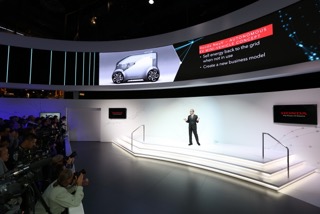
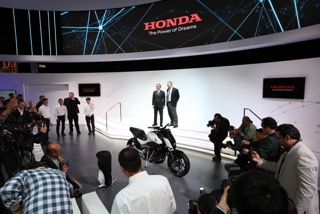
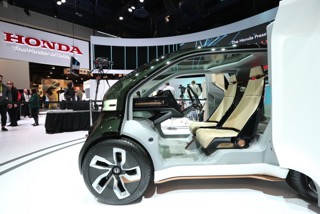
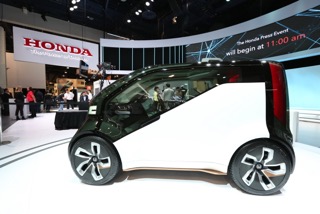
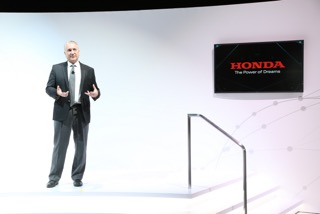
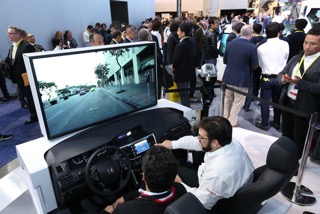
YOSHIYUKI MATSUMOTO
Good morning, ladies and gentlemen. It is a pleasure to be with you.
As Frank said, our goal is to create a Cooperative Mobility Ecosystem, which means collaborating to create intelligent, connected, and fun mobility for the future. The truth is while this is a new concept it is not a new direction for our company.
Ever since our foundation, Honda has studied human beings and focused our efforts on creating technologies that help people. As a result, Honda has created a wide range of personal mobility products including motorcycles, automobiles, power products, aircraft and even humanoid robots. In this way, we have made ourselves useful to people.
Honda remains focused on creating innovative technology that can improve the quality of people’s lives. This type of thinking is the origin of Honda. And we will keep on challenging to create innovative products. To achieve innovation in the future, we believe it will be crucial to create not only products, but also services.
Toward this end, we want to create new value through products and services that help people, get them connected with others and make an emotional connection with our customers.
To create these types of products and services, we will utilize AI, big data and robotics and so on, in addition to traditional mechanical engineering technologies that focus on hardware.
Artificial intelligence will have a big impact on future mobility. That is why we recently opened the Honda R&D Innovation Lab Tokyo. By collaborating with experts and researchers from outside Honda, our engineers will accelerate R&D of artificial intelligence technologies with the goal to put them into practical use.
In the areas of big data and robotics, we will leverage the diversity of our product lineup utilizing data from our motorcycle, automobile and power products business. By combining these technologies and stepping up our R&D activities, we will offer products that help our customers find more joy in their lives.
Today, we are unveiling several research prototypes that demonstrate technologies and ideas drawn from our R&D achievements.
The NeuV is an autonomous EV mini–vehicle concept that creates new possibilities for our customers. Most privately-owned vehicles sit idle 96% of the time. So, the NeuV can function autonomously as a ride sharing vehicle. The NeuV could also sell energy back to the electric grid during times of high demand when the vehicle is not in use. These activities create a new business model for enterprising customers.
And using the new Honda Automated Network Assistant, or HANA, the NeuV can learn from you, detecting the emotions behind your judgments, and then use your past decisions as the basis for selecting new choices.
Our thinking about future mobility is not limited to vehicles. Last year, we opened the API of UNI-CUB, our self-balancing personal mobility device. The UNI-CUB is now programmable, which makes it possible to turn it into an autonomous device that responds to requests to pick up users.
Today, we also are showcasing for the first time our new Honda Riding Assist motorcycle. This technology was created based on our desire to create a motorcycle that gives people the joy of riding with total peace of mind, by greatly reducing the possibility of falling over.
Now, ladies and gentlemen, Let’s see a demonstration of UNI-CUB and Riding Assist.
This Riding Assist does not use large gyroscopes, which would add a lot of weight and limit the bike’s ability to maneuver. It leverages Honda Robotics technology originally developed for the UNI-CUB.
For the future, it is very difficult for any company to have such a broad range of technology areas. Therefore, Honda wants to seek strategic collaboration with technology companies that have entered the mobility industry.
The recent announcement of the MOU between Honda and Waymo is one example of this approach. As these prototypes demonstrate, Honda wants to be a company that creates simple and elegant solutions to common issues and dreams related to mobility.
In this way, we will create joy for people and empower them to increase the quality of their daily lives. To create a range of products and services with great speed, we want to pursue open innovation with companies and experts like many of you here today. Through this open innovation we believe we can create products and services that make people even happier.
Ladies and gentlemen, Let’s do it together! Thank you.